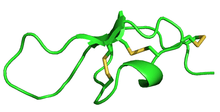Maurocalcine
| Maurocalcine | |
|---|---|
 Structure of Maurocalcine, determined by NMR | |
| Identifiers | |
| Organism | |
| Symbol | MCa |
| PDB | 1c6w |
| UniProt | P60254 |
Maurocalcine is a protein isolated from the venom of the scorpion Maurus palmatus, which belongs to the family Chactidae. It was first reported by Fajloun et al. in 2000.[1]
It is 33 Amino acid residues in length, containing three disulphide bonds which folds into the inhibitor cystine knot motif.[2] It acts by modifying the activity of the type 1 ryanodine receptor.[1]
References
- 1 2 Fajloun, Z., Kharrat, R., Chen, C., Lecomte, E.D.L., Bichet, D., El Ayeb, M., Rochat, H., Allen, P.D., Pessah, I.N., De Waard, M., Sabatier, J.M. (2000). "Chemical synthesis and characterization of maurocalcine, a scorpion toxin that activates Ca2+ release channel/ryanodine receptors". FEBS Letters. 469 (2–3): 179–185. doi:10.1016/S0014-5793(00)01239-4. PMID 10713267.
- ↑ Mosbah, A; Kharrat, R; Fajloun, Z; Renisio, J. G.; Blanc, E; Sabatier, J. M.; El Ayeb, M; Darbon, H (2000). "A new fold in the scorpion toxin family, associated with an activity on a ryanodine-sensitive calcium channel". Proteins: Structure, Function, and Genetics. 40 (3): 436–42. doi:10.1002/1097-0134(20000815)40:3<436::AID-PROT90>3.0.CO;2-9. PMID 10861934.
This article is issued from Wikipedia - version of the 8/28/2015. The text is available under the Creative Commons Attribution/Share Alike but additional terms may apply for the media files.